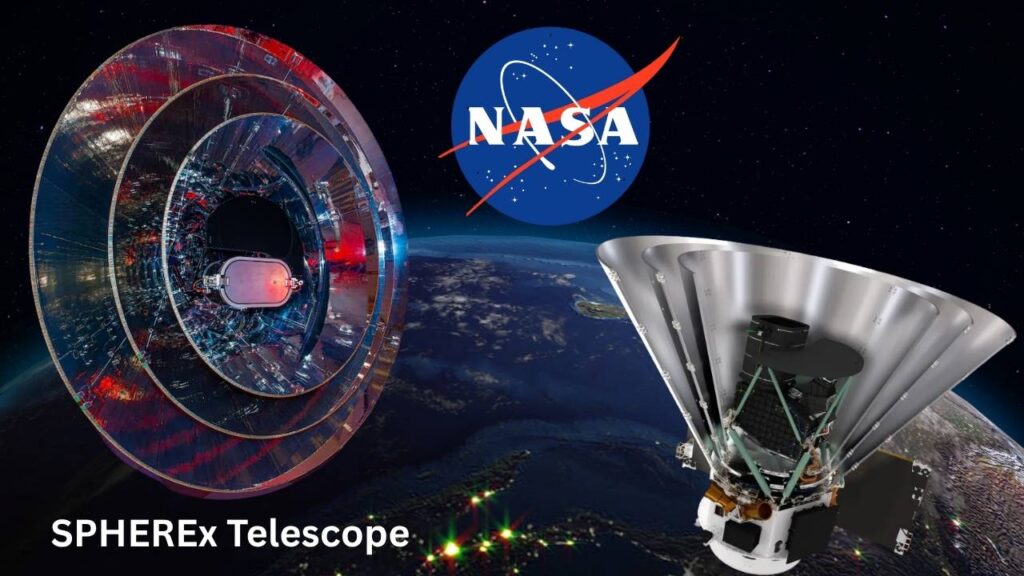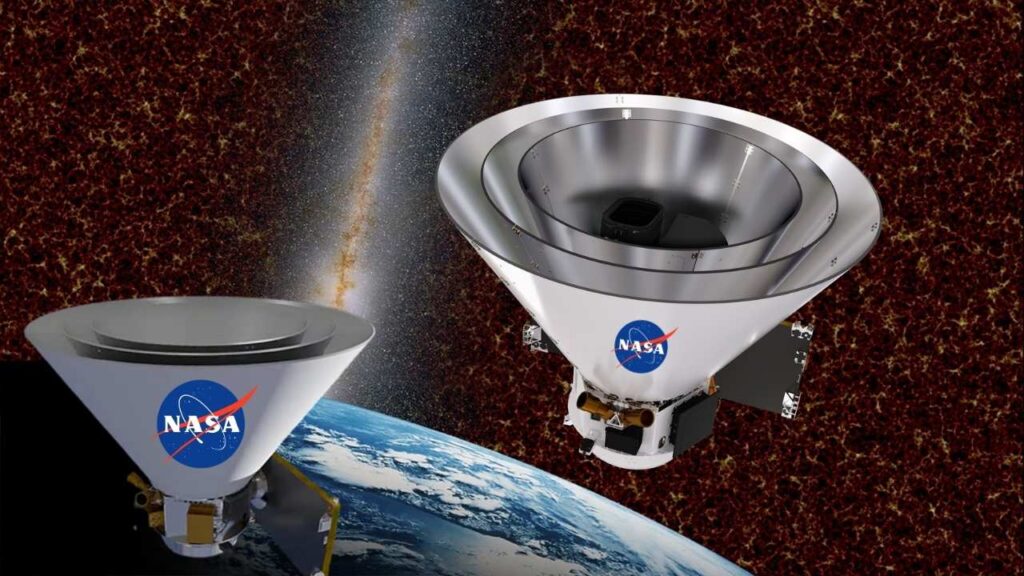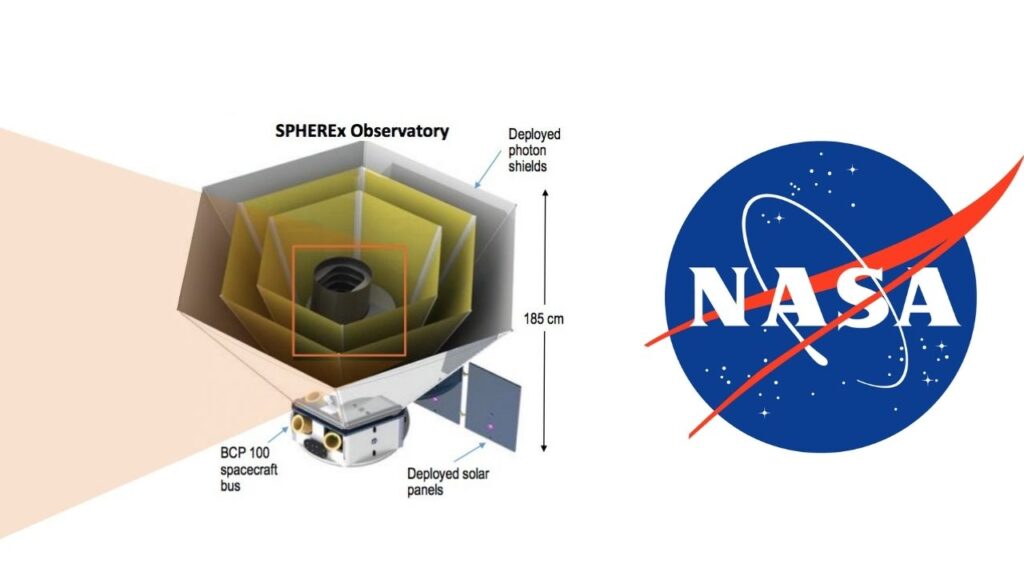NASA’s SPHEREx Telescope Launches to Explore Universe’s Origins: NASA’s SPHEREx Telescope represents a milestone in the quest to understand the universe’s origins. Launched successfully on March 11, 2025, aboard a SpaceX Falcon 9 rocket from Vandenberg Space Force Base, SPHEREx is set to perform the first-ever comprehensive all-sky spectral survey in the near-infrared spectrum. This mission will gather crucial data to explore cosmic inflation, galaxy evolution, and the distribution of life’s building blocks such as water ice and organic molecules.

SPHEREx’s unique approach promises to revolutionize our view of the cosmos, creating an unprecedented three-dimensional spectral map covering millions of stars and galaxies. This article offers a detailed, easy-to-understand guide to the SPHEREx mission, breaking down its scientific goals, technology, and expected impacts with careful attention to accuracy and clarity.
NASA’s SPHEREx Telescope Launches to Explore Universe’s Origins
| Aspect | Details |
|---|---|
| Launch Date | 11 March 2025, aboard SpaceX Falcon 9 rocket from Vandenberg Space Force Base |
| Mission Duration | Approximately 2 years |
| Sky Coverage | Entire sky, surveyed four times |
| Spectral Bands | 102 near-infrared spectral bands |
| Primary Targets | About 450 million galaxies and over 100 million stars |
| Main Objectives | Study cosmic inflation, galaxy evolution, interstellar ices, and organic molecules |
| Orbit | Sun-synchronous low Earth orbit (about 404 miles altitude) |
| Official Website | NASA SPHEREx |
NASA’s SPHEREx telescope embarks on a landmark mission to deepen humanity’s understanding of the universe’s origins and evolution. By performing the first all-sky spectral survey in the near-infrared, it will map hundreds of millions of galaxies and stars, test the theory of cosmic inflation, and chart the distribution of life-essential molecules like water ice and organics. Combining advanced technology with ambitious scientific goals, SPHEREx will provide a rich dataset that benefits professional researchers, educators, and the public alike.
Its findings will complement other space observatories and ground telescopes, helping to answer fundamental questions about the cosmos from its birth to its future.
What is the SPHEREx Telescope?

SPHEREx, short for Spectro-Photometer for the History of the Universe, Epoch of Reionization, and Ices Explorer, is a NASA astrophysics observatory designed to conduct a large-scale spectral survey of the entire sky in the near-infrared wavelengths (0.75 to 5 microns). Unlike traditional telescopes, which mostly capture images or focus deeply on small patches of the sky, SPHEREx’s mission is to collect spectral data simultaneously over wide areas.
The telescope uses innovative linear variable filters (LVFs), which allow it to split incoming light into 102 spectral bands across its detectors. These filters enable SPHEREx to capture detailed spectral fingerprints of millions of celestial objects, enabling scientists to determine their chemical composition, distance, temperature, and other key physical properties.
The goal is to build a massive 3D spectral map that includes:
- Roughly 450 million galaxies, spanning from our local cosmic neighborhood out to billions of light-years.
- Over 100 million stars within our Milky Way.
- Interstellar clouds containing water ice and organic molecules, which are crucial to understanding the potential for life elsewhere in the universe.
The Science Behind SPHEREx: Why It Matters
The universe is vast and complex, and many fundamental questions about its birth and evolution remain unanswered. SPHEREx tackles three major science themes:
1. Probing the Epoch of Cosmic Inflation
The theory of cosmic inflation suggests that the universe underwent a rapid expansion within a tiny fraction of a second after the Big Bang, setting the stage for the large-scale structure we observe today. While inflation is widely accepted, details about its exact nature and mechanisms are still debated.
SPHEREx’s comprehensive galaxy survey will measure how galaxies are distributed across the sky and through cosmic time, which in turn reflects the initial density fluctuations seeded during inflation. This data will provide new tests for competing inflation models, helping cosmologists refine their understanding of the universe’s earliest moments.
2. Charting Galaxy Evolution and the Large-Scale Structure of the Universe
Galaxies grow, merge, and evolve over billions of years, but their formation and the cosmic web’s architecture remain active research areas. By cataloging hundreds of millions of galaxies and determining their distances through spectral redshift measurements, SPHEREx will provide a statistically rich map of how galaxies cluster and change over time.
This detailed dataset will improve models of dark matter distribution and dark energy’s role in accelerating cosmic expansion, offering insights into some of the universe’s most mysterious components.
3. Investigating Water Ice and Organic Molecules in Interstellar Clouds
Water and organic molecules are the building blocks of life as we know it. SPHEREx will survey vast interstellar clouds to detect spectral signatures of ices and organics. Understanding where and how these molecules form and distribute helps scientists piece together the conditions that could lead to life on other planets or moons.
This astrochemical survey is unique because near-infrared light can penetrate dense clouds of dust that block visible light, allowing SPHEREx to detect molecules hidden from most other telescopes.
How Does SPHEREx Work? A Closer Look at the Technology

SPHEREx is engineered with precision instruments optimized for wide-field spectral mapping:
- Near-Infrared Detectors: Sensitive sensors detect light between 0.75 and 5 microns. This range is ideal for penetrating cosmic dust and observing cooler objects that emit most of their light in the infrared.
- Linear Variable Filters (LVFs): These filters vary gradually in wavelength across the detector array, allowing SPHEREx to capture many spectral bands at once without moving parts. This technique is efficient for scanning large sky areas.
- Sun-Synchronous Orbit: Positioned approximately 404 miles (650 km) above Earth in a stable sun-synchronous orbit, SPHEREx maintains a constant orientation relative to the Sun. This ensures thermal stability crucial for sensitive infrared observations.
- All-Sky Survey Strategy: Over its two-year primary mission, SPHEREx will scan the entire sky four times. Multiple passes help improve data quality, reduce errors, and capture transient events.
What Has SPHEREx Accomplished Since Launch?
Since its launch on March 11, 2025, SPHEREx underwent a critical commissioning phase, where instruments were calibrated and fine-tuned. By late March, the telescope produced its first infrared images, confirming its operational readiness.
The initial data collection began shortly after, with early results validating the mission’s capabilities. These first spectral datasets allowed teams to optimize data processing pipelines, which will transform raw data into scientifically usable maps and catalogs.
Over the next two years, SPHEREx is expected to generate:
- Spectral catalogs of over 450 million galaxies with precise redshift measurements.
- Maps of water ice and organic molecule distributions in star-forming regions.
- Large-scale structure maps aiding dark matter and dark energy research.
The Practical Impact of SPHEREx’s Data on Science and Technology
The data from SPHEREx will be a goldmine for researchers worldwide:
- Cosmologists will use it to refine models of the universe’s origin and growth.
- Astrochemists will gain new clues about the prevalence of life’s essential molecules.
- Astronomers can use SPHEREx catalogs to select targets for follow-up observations with ground-based telescopes and space observatories like JWST and the upcoming Nancy Grace Roman Space Telescope.
- Technology developers will analyze SPHEREx’s novel LVF and detector systems for future missions, potentially advancing remote sensing and imaging technologies.
Furthermore, SPHEREx’s open data policy will make these rich datasets accessible to educators and citizen scientists, promoting public engagement in space science.
Step-by-Step Timeline: What to Expect Over SPHEREx’s Mission Duration
- Initial Sky Survey: Beginning immediately after commissioning, SPHEREx will scan the entire sky once, capturing initial spectral data.
- Subsequent Passes: Over the next 18 months, three additional surveys will refine and improve data quality.
- Data Processing: Data will be calibrated, analyzed, and turned into comprehensive spectral catalogs and maps.
- Data Release: NASA will release datasets in phases, allowing the scientific community and public to access and utilize them.
- Scientific Discoveries: Teams worldwide will analyze data to test inflation models, study galaxy evolution, and explore astrochemical phenomena.
- Follow-Up Campaigns: Findings will guide more detailed observations by other telescopes.
South East Queensland Positioned as Global Hub for Quantum Computing Revolution
Next-Generation EV Battery Design Uses Less Lithium While Delivering Strong Performance
Researchers Develop Early Prototype Of Sodium-Air Fuel Cell With Promising Efficiency
FAQs About NASA’s SPHEREx Telescope Launches to Explore Universe’s Origins
Q1: How is SPHEREx different from other infrared observatories?
SPHEREx conducts a unique, all-sky spectral survey at moderate resolution over a broad near-infrared range, whereas telescopes like JWST focus on deep, high-resolution observations of selected objects.
Q2: Will SPHEREx find new planets or stars?
While not designed for direct planet detection, SPHEREx will catalog millions of stars and provide data that may assist in identifying candidates for further study.
Q3: How will SPHEREx data be made available?
NASA commits to public data releases, enabling scientists, educators, and the public to access SPHEREx’s spectral catalogs and maps.
Q4: Can SPHEREx’s findings affect everyday technology?
Indirectly, yes. Innovations in detector and filter technology may influence imaging and sensing applications beyond astronomy.
Q5: What happens after the initial two-year mission?
Depending on spacecraft health and funding, NASA may extend SPHEREx’s operations to collect more data or pursue additional science goals.






